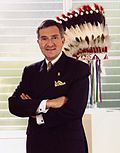Cheyenne people
The Cheyenne (/ʃaɪˈæn/ shy-AN) are a people of the Great Plains. The language they use, the Cheyenne language, is part of the Algonquian language group. Now, the Cheyenne people are broken into two nations seen by the government: the Southern Cheyenne, who are part of the Cheyenne and Arapaho Tribes in Oklahoma, and the Northern Cheyenne, who represent the Northern Cheyenne Tribe of the Northern Cheyenne Indian Reservation in Montana. The Cheyenne comprise two Native American tribes, the Só'taeo'o or Só'taétaneo'o (usually spelled as Suhtai or Sutaio) and the Tsétsêhéstâhese (also spelled as Tsitsistas, like [t͡sɪt͡shɪstʰɑs][3]). The tribes connected in the early 19th century.
 | |
| Total population | |
|---|---|
| 22,970 (Northern: 10,840;[1] Southern: 12,130[2]) | |
| Regions with significant populations | |
| United States (Montana, Oklahoma) | |
| Languages | |
| Cheyenne, English, Plains Sign Talk | |
| Religion | |
| traditional tribal religion, Native American Church, and Christianity | |
| Related ethnic groups | |
| Arapaho, Blackfoot, Suhtai, and other Algonquian peoples |
At the time of their first European contact, the Cheyenne lived in what is now Minnesota. They were close allies of the Arapaho and loosely aligned with the Lakota. By the early 18th century, they were forced west across the Missouri River and into North and South Dakota, where they adopted the horse culture. After settling the Black Hills of South Dakota and the Powder River Country of present-day Montana and Wyoming, they introduced the horse culture to Lakota people around 1730. With the Arapaho, the Cheyenne pushed the Kiowa to the Southern Plains. In turn, they were pushed west by the more numerous Lakota.[4]
Cheyenne People Media
Cheyenne hide dress, c. 1920, Gilcrease Museum
Cheyenne beaded hide shirt, Woolaroc
W. Richard West Jr., former director and cofounder of the Smithsonian's National Museum of the American Indian
Cheyenne woman photograph by Edward S. Curtis, 1930
Chief Wolf-on-the-Hill (Cheyenne), portrait by George Catlin, 1832, in Fort Pierre, South Dakota
Ledger drawing of a Cheyenne warrior with pronghorn horned headdress, symbol of the Crazy Dog Society.
References
- ↑ "Northern Cheyenne Tribe website". Archived from the original on February 2, 2011. Retrieved November 11, 2013.
- ↑ Oklahoma Indian Affairs. Oklahoma Indian Nations Pocket Pictorial Directory. Archived 2009-02-11 at the Wayback Machine 2008:7
- ↑ "Cheyenne, Southern." Archived 2009-02-28 at the Wayback Machine Oklahoma History Center's Encyclopedia of Oklahoma History and Culture. Retrieved 3 July 2013.
- ↑ Walker, James R. & DeMallie, Raymond J. "Lakota Society" 1992.








